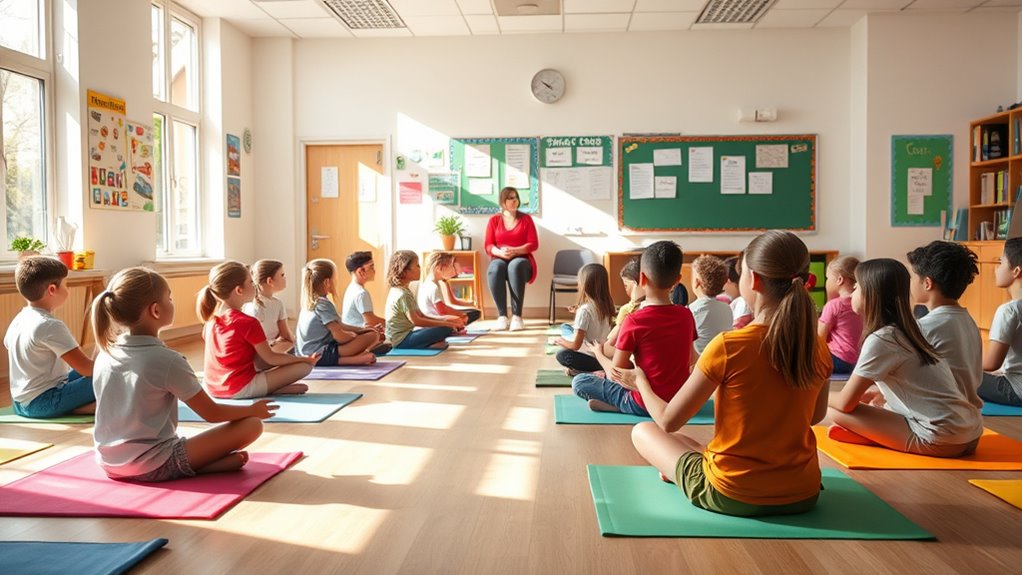Effective mindfulness training for teachers helps create engaging classrooms by promoting emotional regulation and focus. When educators are well-prepared, they can confidently lead exercises that reduce stress and improve student attention. This environment encourages better grades, perseverance, and resilience, supporting both academic success and emotional growth. As teachers foster a calm, mindful atmosphere, students develop stronger grit and motivation. Keep exploring how integrating local resources and ongoing training can maximize these benefits even further.
Key Takeaways
- Teacher training in mindfulness enhances classroom engagement, leading to improved student grades and emotional resilience.
- Effective mindfulness programs reduce distractions and anxiety, fostering better focus and academic performance.
- Mindfulness cultivates grit by teaching students to handle setbacks and persevere through challenges.
- Well-implemented programs promote emotional regulation, decreasing behavioral issues and supporting sustained learning.
- Incorporating local resources in teacher training maximizes the long-term impact of mindfulness on student achievement.

Have you ever wondered how schools can better support students’ mental health and focus? One effective approach gaining traction is integrating mindfulness practices into the school day. But for mindfulness programs to truly make an impact, teachers need proper training. When educators understand how to facilitate mindfulness exercises, they can create a classroom environment that encourages student engagement and emotional regulation. Well-trained teachers know how to introduce mindfulness in a way that resonates with students, making it easier for them to adopt these techniques independently. This training isn’t just about demonstrating breathing exercises; it’s about fostering a mindset that emphasizes presence, patience, and self-awareness. When teachers are confident in their ability to guide mindfulness activities, students are more likely to participate actively, leading to higher levels of engagement.
Increased student engagement is a critical benefit of mindfulness in schools. When students are more engaged, they tend to perform better academically and develop stronger interpersonal skills. Mindfulness helps students stay focused on their tasks by reducing distractions and managing anxiety. As a result, they’re able to concentrate longer and absorb information more effectively. This heightened focus translates into better grades and a more positive attitude toward learning. Furthermore, mindfulness encourages students to pause and reflect before reacting, which can reduce behavioral issues and promote a calmer classroom atmosphere. When students feel more connected to their own emotions and learn to regulate them through mindfulness, they become more invested in their education and relationships with peers. Incorporating teacher training in local resources can enhance the effectiveness of these programs.
Implementing mindfulness programs also fosters resilience and grit, essential qualities for academic success and personal growth. When students learn to handle stress and setbacks through mindfulness techniques, they build perseverance and emotional strength. This resilience helps them stay motivated even when faced with challenges, improving their overall academic performance. Schools that prioritize teacher training in mindfulness often see a ripple effect: motivated teachers create more engaging lessons, and engaged students develop better mental health habits. This cycle leads to a more supportive learning environment where students thrive physically, emotionally, and academically.
Frequently Asked Questions
How Does Mindfulness Impact Students’ Long-Term Academic Success?
When you practice mindfulness, you build skills that boost your long-term benefits, including improved focus, emotional regulation, and stress management. These skills enhance your academic resilience, helping you bounce back from setbacks and stay committed to your goals. Over time, mindfulness fosters a mindset that supports sustained success, making it easier for you to navigate challenges and maintain high performance in school and beyond.
Are There Any Age-Specific Mindfulness Techniques for Younger Students?
You can use age-specific mindfulness techniques like simple breathing exercises and guided imagery for younger students. These methods help them focus and calm their minds effectively. For example, teach them to take deep breaths or imagine happy places during stressful moments. Keep activities short and engaging, making it easier for young students to grasp and enjoy mindfulness, which supports their emotional regulation and concentration.
What Challenges Do Schools Face When Implementing Mindfulness Programs?
When implementing mindfulness programs, you may face challenges like limited teacher training and difficulties with curriculum integration. Schools often struggle to guarantee teachers are well-prepared to guide students effectively and fit mindfulness practices into busy schedules. Additionally, securing resources and gaining administrative support can be tough. Overcoming these hurdles requires ongoing training, flexible planning, and a commitment to embedding mindfulness seamlessly into everyday learning experiences.
How Can Parents Support Mindfulness Practices at Home?
To support mindfulness practices at home, you should prioritize parental involvement by setting aside time for regular mindfulness activities. Incorporate simple routines like deep breathing or meditation into your daily schedule, making it a natural part of your home routine. Encourage your child to share their feelings and practice patience, helping them develop resilience and focus. Your active participation reinforces mindfulness skills, boosting their emotional well-being and academic success.
Are There Cultural Considerations in Adopting Mindfulness in Diverse Classrooms?
When adopting mindfulness in diverse classrooms, you should consider cultural relevance and diversity considerations. You might find that some students connect more easily with practices rooted in their cultural backgrounds, so adapt techniques accordingly. Respect different beliefs and traditions, and incorporate culturally inclusive activities. This approach helps guarantee mindfulness benefits all students, fostering a supportive environment where everyone feels valued and understood.
Conclusion
By embracing mindfulness in your school, you plant seeds of growth that bloom into better grades and unwavering grit. The evidence clearly shows this practice acts as a lighthouse, guiding students through academic storms with calm and clarity. When you incorporate mindfulness, you’re not just teaching lessons in the classroom; you’re nurturing resilient minds capable of weathering life’s challenges. It’s a small step with the power to transform your school into a thriving garden of potential.










